We were thrilled to see over 150 entries to the photo contest, and we thank all of those who shared their photographs with us. Three winners were chosen by a panel of Schuylkill Center staff.
Winners:

David Sonnen’s landscape shows us a wintery world that is separate from ourselves and yet intricately linked to our history. The gentle light infuses the entire image with a sense of timelessness while the small parts of fencing that appear near the bottom of the image remind us that we are a part of the landscapes we observe.

In Tyrice James’ photograph, a brilliant sense of movement make the image feel present and locates us within the nature we live with. The feeling of having captured a specific moment, as seen in the snow flying through the air, is deeply captivating.

The beautiful observation of nature demonstrated through Mikaela Reeves Larsen’s photograph draws us into the cold of winter while offering hope for spring. Those berries further remind of of the stored food wildlife require to survive the winter, much as we turn to our own stored reserves: living off of hope until spring arrives.
We’re also happy to honor six runners-up. Christina Catanese and Anna Lehr Mueser comment on the runner-up photographs below.
Runners-up:
From Christina Catanese, Director of Environmental Art:
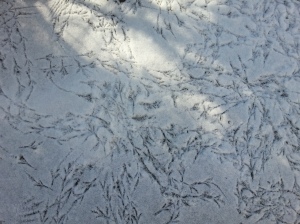
Lea Gooneratne-Riedi
In the winter woods, we can often find evidence of animals in the landscape even when we can’t see them, and I love that this photo shows an example of that. It implies a story – a bird, or many birds, going about their day in the snow. The movement patterns are traceable to a certain degree, but are mixed and not linear, leaving us to wonder about the details of the story. The framing of the picture doesn’t draw your eye to one focal point, but rather creates an intricate texture that it’s easy to get lost in viewing. Seeing nature often means finding the unexpected in a landscape when you take a closer look, as in this case, the patterns unintentionally generated by feathered friends.
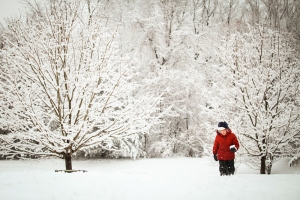
Judith Krasinski
This scene induces a feeling of deep quiet, and the soft quality of the background gives the impression of freshly fallen snow. The solitary figure, small in the landscape, makes me imagine myself in her position – being alone in the snowy woods, which is one of my favorite parts of winter. Compositionally, the photo is also impressive. The uniform colors and textures of the background offset the woman in the landscape; the brightness of the red coat and even the woman’s skin stand out against the white, branching woods.
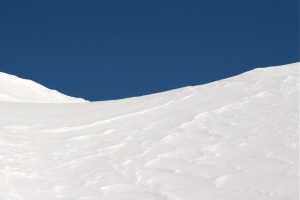
Ann Kent
The stark contrast of color in this photo – the deep blue and the bright white – and the sharp, clean lines seem to reference the harsher side of winter. Winter isn’t always kind, especially to animals (and, indeed, people) that don’t have places to warm up in or readily available food. There is also a feeling of unsettling displacement in this landscape. It makes you wonder: what is the scale here, and where was this taken? Still, I like the uncertainty about it, and its feeling of total emptiness – not even a footprint in sight – evokes beauty even in its bleakness.
From Anna Lehr Mueser, Public Relations Manager:
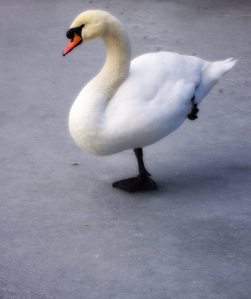
Eric Smith
The soft glow of this photograph draws us into the moment, emphasizing both the beauty of the winter and the deep cold of this season. The photographer seems to have surprised the swan in this moment, capturing it as it withdraws one foot into warm feathers. The bright white of the swan and the glowing orange of its beak are in stark contrast to the dull grey of ice. Everything about this photograph speaks of the cold and of endurance, showing us what winter means.
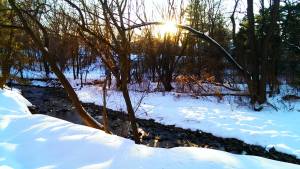
Mitch Berger
The contrast of warm light and the soft colors of sunset pair beautifully in this photo with the cool blues of the snow and the dark lines of trees and stream. Mitch Berger’s photo reminds me of the joy of discovering something unexpected and beautiful. The sunlight lighting on the trees transforms the scene from beautiful to stunning, each detail vivid and alive, despite quite stillness of the image.
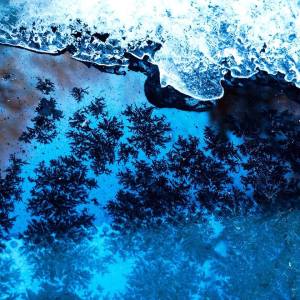
Gretel DeRuiter
This remarkable photograph is at first hard to understand – the ice and frost are striking, the colors incredible, capturing the chilling cold of the season, yet one is at first thrown off by the image. Where is this? What is this? When it becomes apparent that we are looking at a windshield, this image seems to resolve itself and we see the true brilliance of it. This is not only how the photographer sees, pictures, photographs nature, this, ice on the car, is the nature all of us have lived with every day this winter. I loved this photo because it perfectly located us within our environment and brought nature, even cold frosty nature, into the every day.























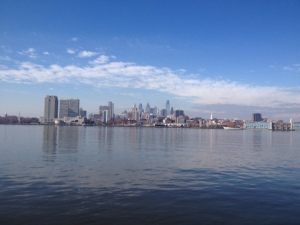
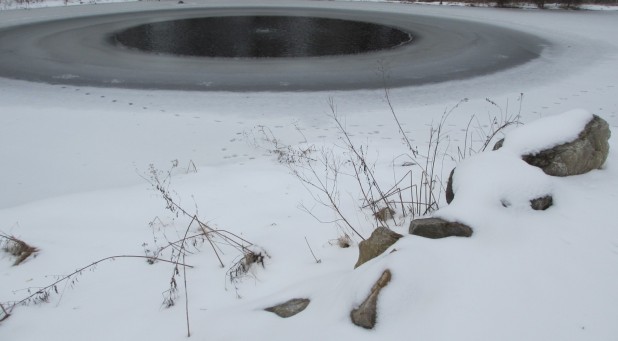
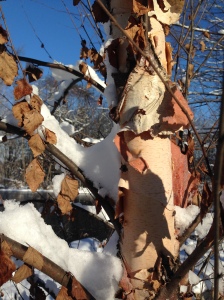
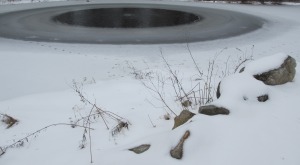


 Rain is usually given a long narrow space to inhabit: gutters, downspouts, underground pipes. People can walk practically anywhere in a building and on the surrounding landscape. What if this paradigm got turned on its head? Give people a more narrow path of movement around a site while rain gets plenty of space to spread out and linger? How would our built environments change? And how would it change our relationship to rain?As an eco-artist, I want art to be an advocate of rain. Art is good at giving meaning to the leftover or abandoned aspects of the world—and rain is one of those abandoned elements. Though a
Rain is usually given a long narrow space to inhabit: gutters, downspouts, underground pipes. People can walk practically anywhere in a building and on the surrounding landscape. What if this paradigm got turned on its head? Give people a more narrow path of movement around a site while rain gets plenty of space to spread out and linger? How would our built environments change? And how would it change our relationship to rain?As an eco-artist, I want art to be an advocate of rain. Art is good at giving meaning to the leftover or abandoned aspects of the world—and rain is one of those abandoned elements. Though a 



